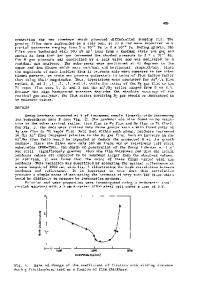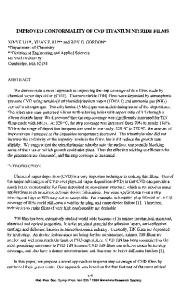Effect of a Titanium Interlayer on the Performance of the Titanium Nitride Diffusion Barrier
- PDF / 2,295,221 Bytes
- 6 Pages / 417.6 x 639 pts Page_size
- 4 Downloads / 357 Views
However. TiN and Al are in fact thermodynamically unstable [3] and TiN reacts with
Al and forms TiAI3 and AIN, so that the integrity of the barrier is destroyed [4]. Also, the columnar grain structure of sputtered TiN is inadequate as a barrier since it offers fast diffusion paths [5]. A thin Ti buffer layer has been employed between the Al layer in metal-I and the TiN barrier in metal-2 to reduce the via resistance and improve the electromigration performance [6]. Since interdiffusion of Ti and Al occurs at temperatures as low as 350'C [7], Ti and Al will react to form a Ti-Al compound layer upon annealing. The newly formed layer is expected to be TiA13, which shall also serve as an additional barrier to enhance the barrier reliability because TiAl3 is thermodynamically in equilibrium with Al and TiN. Since Ti also reacts with Cu to form a stable phase, a similar scenario can be expected for the Cu metallization system as well. In this paper, thermal stability as well as the electrical characterization of metal/TiN/ and metal/Ti/TiN/ systems were investigated to determine the effect of a thin Ti interlayer on the performance of the TiN barrier in the Al/ and Cu/ metallization systems. EXPERIMENT P-type silicon (100) wafers of 20 Q-cm resistivity were used as substrates in this study. The substrates were degreased in organic baths and chemically etched with diluted HF solution 21 Mat. Res. Soc. Symp. Proc. Vol. 563 ©1999 Materials Research Society
just prior to loading into the deposition chamber. TiN-Al (or TiN-Cu) and TiN-Ti-Al (or TiNTi-Cu) films were sputtered sequentially on the Si substrates without breaking the vacuum. The base pressure of the sputtering system was 5 X 10"' Torr and the operation pressure was 8 mTorr. The Ti, Al and Cu films were sputtered in an Ar discharge from Ti, Al and Cu targets, respectively. The TiN films were deposited by reactive sputtering from a Ti target in an Ar/N 2 plasma. The resistivity of the resulting TiN film was about 130 gOt-cm. Thicknesses of the TiN. Ti, Al and Cu films were 100, 30, 300, 250 nm, respectively. The multilayered samples were then cut into several pieces and annealed in a tube furnace at 400-600°C for 30 min in flowing Ar for Al metallization, and at 450-750°C for 30 min in flowing H2 for Cu metallization. The thermal reactions were characterized by Auger electron spectroscopy, x-ray diffraction using a glancing angle (5 degrees) of beam incidence, and scanning electron microscopy equipped with wavelength-dispersive spectrometry (WDS) of x-rays. Sheet resistances of samples, before and after annealing, were measured with a four-point probe. RESULTS AND DISCUSSION Figure 1 shows the scanning electron micrographs on the surfaces of the Al/TiN/ and Al/Ti/TiN/ samples after annealing at various temperatures. As-deposited samples of both metallization schemes had a smooth surface (not shown). For the A1/TiN/ system, the SEM micrograph showed small hillocks on the surface after annealing at 400°C for 30 min
4000C
5000 C
6000C
Al (300nm) TiN (I00nm)
Al
Data Loading...









